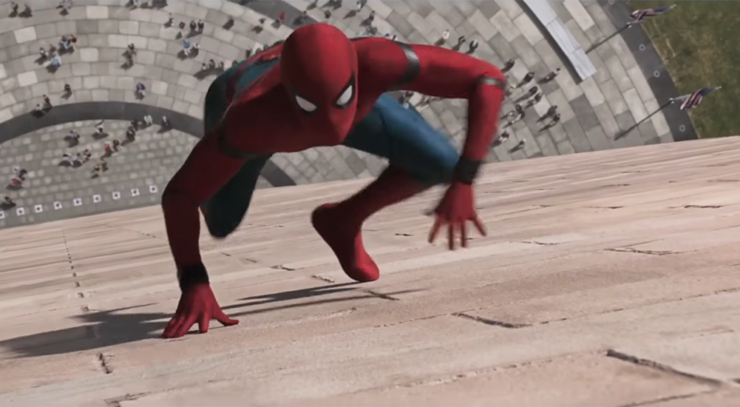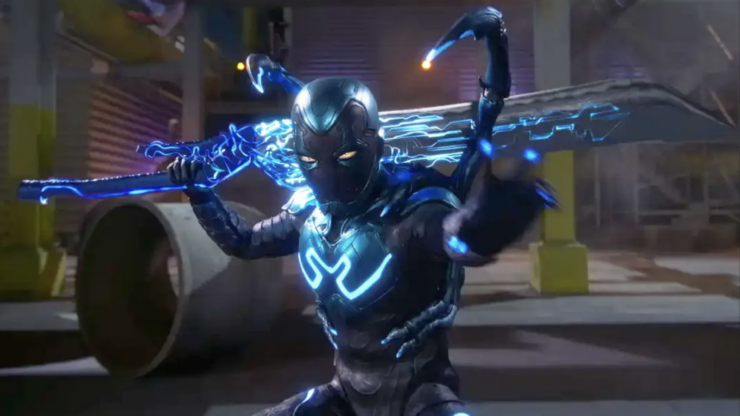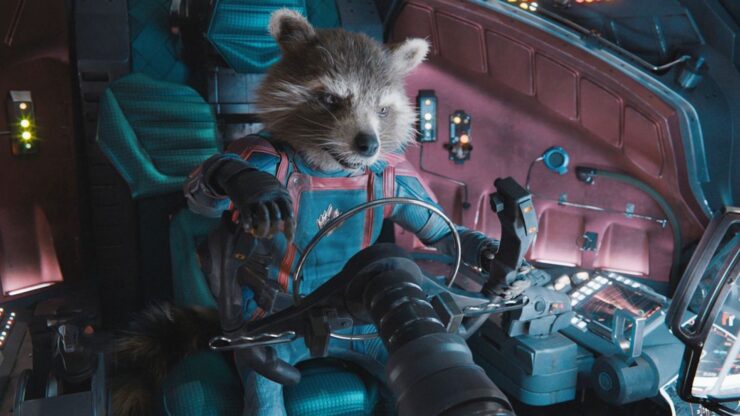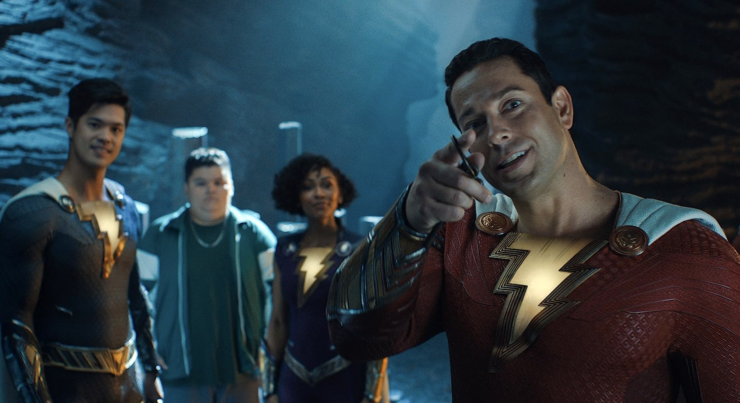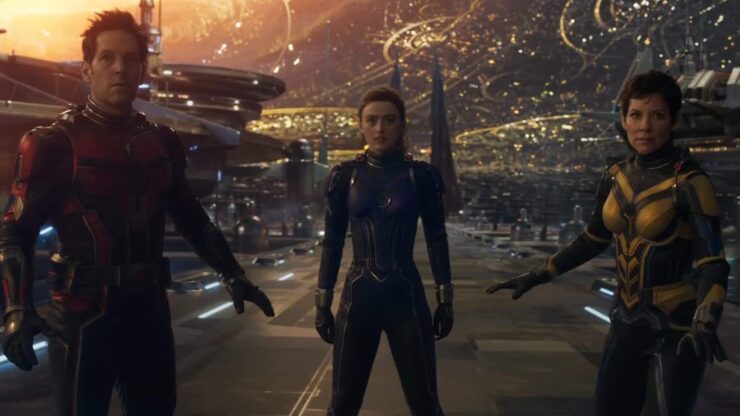No single character in Marvel’s pantheon has had more comic book titles than Spider-Man. The Amazing Spider-Man has continued to be published in some form or other since 1963, and he’s had an absurd number of secondary titles. There have been many months over the past fifty-plus years when there’s been a new Spider-title every week. (As an example, in the early 1990s there were four monthly titles, The Amazing Spider-Man, The Spectcular Spider-Man, Web of Spider-Man, and Spider-Man.)
The character had enough history all on his own from this plethora of publications that Sony tried to create a “Spider-Man Cinematic Universe” with the Marc Webb-directed, Andrew Garfield-starring films. However, the movie that started to build that universe, The Amazing Spider-Man 2, was something less than a howling success, and Sony had to go for Plan B.
The infamous Sony hack of 2014 revealed that Sony had been talking to Marvel Studios about the possibility of their producing a new trilogy of Spider-Man films, even as they were also making plans for a third Webb-directed film. (There was also talk of bringing Sam Raimi back to do more Spider-films.) The disappointing performance of ASM2 and the revelation that Sony was interested in doing a deal with Marvel Studios got those conversations back on track (Marvel originally rejected Sony’s offer). Kevin Feige has long wanted Spider-Man to be part of the MCU, and this was a way to make it happen.
After introducing the character to this corner of the Marvel Universe in Captain America: Civil War, the search was on for screenwriters and directors. The team of John Francis Daley and Jonathan Goldstein were considered to direct, and did do one of the drafts of the script, pulling on their experience in sitcoms to bring some ground-level humor. Jon Watts was eventually tabbed to direct—besides Daley and Goldstein, Jonathan Levine, Ted Melfi, Jared Hess, and Jason Moore were considered—and he also wanted to take a ground-level approach, as he felt the appeal of Spider-Man was that he was a regular person with regular-person problems who happened to have super-powers. In contrast to the big epic feel of most of the MCU movies, Watts wanted a Spider-Man who was an ordinary guy—a friendly neighborhood Spider-Man, as it were.
Part of the deal with Sony is that one MCU character has to appear in an MCU Spidey film, and Tony Stark was the obvious choice to bring in to continue his role as Spidey’s mentor that he had in Civil War, with Pepper Potts and Happy Hogan along for the ride.
Michael Keaton (last seen in this rewatch as the title character in 1989’s Batman and Batman Returns) debuts the role of Adrian Toomes, a.k.a. the Vulture, one of Spider-Man’s longest-tenured villains, having first appeared in the comics in the second issue of Amazing Spider-Man in 1963. Garcelle Beauvais and Laura Harrier play Toomes’s wife Doris and daughter Liz, respectively, with Liz being one of Peter’s classmates at the Midtown School of Science and Technology.
Screen versions of a few other members of Spidey’s rogues’ gallery appear, including Bokeem Woodbine as Herman Schultz, a.k.a. the Shocker; Logan Marshall-Green as Jackson Brice, who was a version of the Shocker both here and in the Spectacular Spider-Man cartoon from 2008, but was also Montana of the Enforcers in the comics; Michael Chemus as Phineas Mason, a.k.a. the Tinkerer; Michael Mando as Mac Gargan, who in the comics eventually became the Scorpion (Gargan has a scorpion tattoo on his neck by way of tribute to the character’s comics persona); and Donald Glover as Aaron Davis, who in the comics is the shady uncle of Miles Morales, who would take on the mantle of Spider-Man (Glover voiced Miles Morales in the Ultimate Spider-Man cartoon that was running while this film was being made, and Davis here does make a reference to his nephew).
We also get to see the Department of Damage Control, based on a company created in the comics by the late great Dwayne McDuffie, which is called in to clean up after superhero battles. Tyne Daly appears as the head of the DODC, which in the MCU is a joint operation between the U.S. Government and Stark Industries.
Back from Civil War are Tom Holland as Peter Parker, Marisa Tomei as Aunt May, Robert Downey Jr. as Stark, Chris Evans as Captain America (in a bunch of PSAs shown at Midtown), and Kerry Condon as F.R.I.D.A.Y. Back from Iron Man 3 are Jon Favreau as Hogan and Gwyneth Paltrow as Potts. Back from The Incredible Hulk is Martin Starr, who reprises his role as an academic coach, named Mr. Harrington here. Back from Captain America: The First Avenger is Kenneth Choi as Principal Morita, the descendant of Jim Morita of the Howling Commandos in World War II.
Parker’s fellow classmates besides Liz include Zendaya as Michelle Jones (who decides at the film’s end to go by “MJ”), Jacob Batalon as Ned, Tony Revolori as Flash, and Angourie Rice as Betty.
Also introduced in this film are Jennifer Connolly as Karen, the A.I. in the Spider-suit, Hemky Madera as the bodega owner Mr. Delmar, Christopher Berry as Randy, and Hannibal Buress as Coach Wilson.
Holland, Downey Jr., Evans, Paltrow, Batalon, and Condon will next appear in Avengers: Infinity War. Favreau and Tomei will next appear in Avengers: Endgame. Zendaya, Revolori, and Rice will next appear in Spider-Man: Far from Home.
Homecoming was a massive hit, as just the domestic gross was almost double the budget, and a sequel was green-lit tout de suite, which would serve as the coda to Phase 3 in general and the Infinity War/Endgame two-parter in particular, and which we’ll cover in December. After a brief breakdown of negotiations, Sony and Disney came to terms for a new deal, and a third film with Holland will be released in the summer of 2021.
“Dude, you’re an Avenger, if anyone has a chance with a senior girl, it’s you!”
Spider-Man: Homecoming
Written by Jonathan Goldstein & John Francis Daley and Jon Watts & Christopher Ford and Chris McKenna & Erik Sommers
Directed by Jon Watts
Produced by Kevin Feige and Amy Pascal
Original release date: July 7, 2017
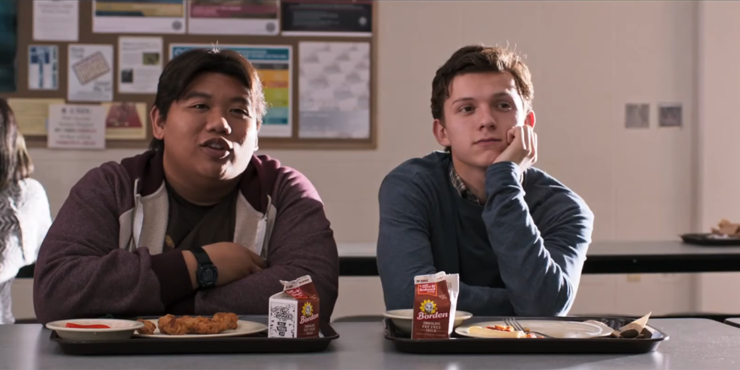
In 2012, after the Chitauri invasion, Adrian Toomes leads a crew of workers who have the city contract to clean up the mess at Stark Tower. But then the Department of Damage Control comes in and says that it’s their responsibility now. Toomes is not happy about losing the contract, as he paid for extra trucks and extra workers, and he’s out all that money now.
However, one of those extra trucks is back at Toomes’s warehouse and is full of alien technology salvaged from the site. Toomes decides to defy federal orders to give everything back and keep the truck.
Time passes. (The caption says eight years, but that would put this movie in 2020, and every other chronological cue of the MCU puts movies in the year they were released, so let’s just say “several” years later…) Toomes and his gang have spent the time salvaging alien tech from various super-battles—the Triskelion’s destruction, e.g.—and selling it on the black market.
Peter Parker kept a video diary of his trip to Berlin, and we see Happy Hogan driving him to the airport, flying to Europe with him, taking him to his hotel, and finally giving him the suit he wore in the battle at Leipzig/Halle Airport. We see bits of the battle that Parker recorded on his phone, and then they return to Queens, with one final “alibi video” for Parker’s Aunt May, saying how well the “Stark Industries retreat” went.
Stark then tells Parker to keep things low-key, to handle street-level stuff, and the Avengers will call if they need him.
Parker continues to go to school, and his cover story for being Spider-Man is an internship at Stark Industries. He keeps waiting for a call to a new mission with the Avengers, and continues to help people as Spider-Man, but he also quits his extracurricular activities—including the Academic Decathalon, which is going to the Nationals in Washington D.C. soon, but Parker doesn’t want to be out of town in case the Avengers need him. We also meet several of his classmates, including his best friend Ned; Michelle, who is dismissive and insulting to pretty much everyone; Liz, the captain of the Decathalon team, and also the organizer of the upcoming homecoming dance, and on whom Parker has a major crush; and Flash, who regularly torments Parker (mostly due to being jealous of Parker being smarter than him), and who also takes Parker’s place on the Decathalon team.
His patrols are a mixed bag. At one point, he stops what he thinks is a car thief, but it turns out to be someone just getting in his car, for which he is berated by a plethora of cranky New Yorkers, including one who looks just like Stan Lee. He also gives a woman directions, and she gives him a churro for his trouble. He reports all this to Hogan’s voicemail—Hogan doesn’t answer his calls or respond to his texts.
He stops an ATM robbery by four guys in Avengers masks who are wielding high-tech weapons. While Spidey foils the robbery, the bodega across the street is destroyed. (Spidey manages to rescue Mr. Delmar and the deli’s cat Murph.)
When Parker goes home, he crawls into the apartment through the window and walks along the ceiling and then closes the door—only then belatedly realizing that a shocked Ned is sitting on his bed, waiting for him to come home so they could put together a LEGO Death Star together.
Parker swears Ned to silence—he can’t let May know about him being a hero, as she’s been through too much as it is—but Ned won’t stop asking questions about being Spider-Man. When they overhear Liz saying that she thinks Spider-Man is fantastic, Ned blurts out that Peter knows Spider-Man. Flash is skeptical, and Parker is furious at Ned for even saying it, but it gets them both invited to the party at Liz’s house that weekend, in the hopes that Parker will bring Spider-Man along.
Parker and Ned go to the party, driven there by May. The plan is to have Spider-Man show up, say his friend Peter invited him, give Ned a fist-bump, and then head out.
However, after he changes into his uniform, he sees an energy discharge very similar to that of the weapons in the ATM robbery, and he goes to investigate, only to find an arms deal going down. Two of Toomes’s people—Herman Schultz and Jackson Brice—are trying to sell weapons to Aaron Davis. Spider-Man breaks up the arms deal, and Schultz and Brice try to get away, with Spidey chasing them through the suburbs. They don’t lose him until Toomes himself shows up in his mechanical wings and drops Spidey into a bay. Spidey almost drowns, tangled in the parachute he didn’t realize his suit had, and is rescued by a remote-controlled Iron Man. Stark himself is halfway ’round the world, and has been monitoring the Spider-Man suit. He advises Parker to stay away from this, as it’s too big for him. He should just be a friendly, neighborhood Spider-Man.
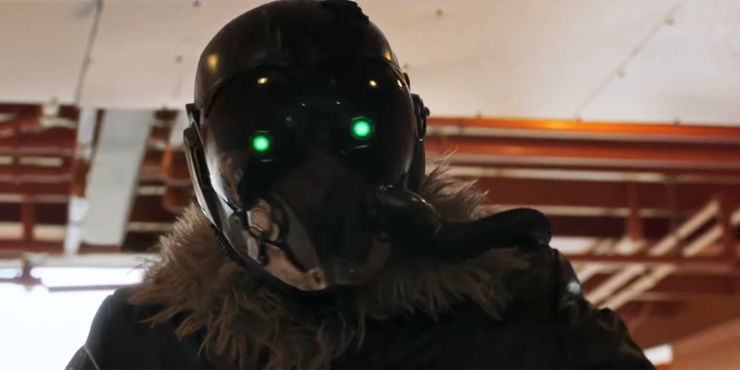
Because Parker disappeared from the party and Spidey never showed, Flash—who is the DJ at the party—starts a call-and-response chant of “Penis” followed by “Parker,” thus solidifying Parker and Ned’s status as losers.
Toomes is furious at Brice for making such a public scene. Brice is unconcerned, and Toomes fires him, prompting Brice to threaten to expose Toomes’s operation if he does. Toomes grabs a weapon and shoots Brice, disintegrating him—to his surprise, as he thought it was the anti-gravity gun. His tinkerer, Phineas Mason, explains that that was the disintegration ray, and now Brice is dead. Brice had been using a gauntlet that shoot electric blasts, and Toomes gives the gauntlet to Schultz.
Spidey did manage to put a tracker on Schultz, and he and Ned see that he’s in Maryland. Best way to get there is to put himself back on the Decathalon team, since it’s on its way to Washington D.C. They also have a piece of tech that Brice left behind in the chase, which they examine, but can’t quite figure out what it is.
In their shared hotel room in D.C. the night before the Decathalon, Ned and Parker manage to remove the tracker from the suit and also disable the “training wheels” protocol, which activates the suit’s A.I. (whom Parker eventually names “Karen,” as that’s nicer than “Suit Lady”) and lots of other functions. (Too many, as Stark’s tendency toward excess is seen in things like the kill protocol and the many types of webbing.)
Spider-Man stops Toomes from stealing items from a DODC van, but winds up unconscious in the van itself. When he wakes up, he’s in a secure DODC facility with a time lock. At first, Parker just waits it out, having several conversations with Karen, but eventually discovers that the device they salvaged from Brice—and which is currently in Ned’s pocket—is a Chitauri grenade. Working through the night to dope out the time lock, Parker eventually breaks through and escapes—having missed the Decathalon entirely, though the Midtown team wins anyhow. They go to the Washington Monument as part of their post-victory celebration, but the security scanner Ned goes through activates the grenade, which goes off while they’re in the elevator. The emergency systems will hold it in place for a bit, but the damage from the grenade has compromised it. Spidey arrives in the nick of time to save everyone, though it’s difficult (and involves defying the Metro Police, who only see a weirdo in a onesie climbing the side of a tourist attraction). Liz is the last one out of the elevator before it collapses—and then it does collapse, but Spidey manages to save her.
When they return to New York, Parker is given detention. He also manages to work up the courage to ask Liz to the homecoming dance. Liz, who views Parker’s bailing on the Decathalon somewhat philosophically given that she almost died that day, accepts.
Karen has recorded everything Parker has done while wearing the suit, and she’s able to run facial recognition on the arms deal that Spidey broke up. There’s no record of Schultz or Brice, but Davis has a criminal record. Spidey goes to question him, initially in the suit’s “interrogation mode,” which fails rather spectacularly. But the pair of them wind up bonding over their shared love of the sandwiches at Mr. Delmar’s bodega, and Davis says he knows where Toomes’s next deal will be: on the Staten Island Ferry.
Spidey shows up to scotch the deal between Toomes and a criminal named Mac Gargan, but he winds up stepping on an FBI sting, and then one of the weapons goes off and cuts the ferry in half. Spidey manages to stave off the boat sinking until Iron Man arrives to save the day. After Iron Man welds the ferry back together, the pair of them fly off so Stark and Parker can have a long talk. Stark told Parker to back off and he didn’t. Stark was the one who called the FBI, and Parker screwed the pooch and nearly got a lot of people killed. Stark demands the suit back.
Parker goes home to May, who is worried sick. She knows Parker has been sneaking out and she’d been trying to reach him all day, and she can’t not know where he is and what he’s doing. He admits only that he lost the Stark internship.

He takes Liz to the homecoming dance. Arriving at her house, he discovers, to his abject terror, that Liz’s father is Adrian Toomes. Parker barely manages to hold himself together as Toomes drives them to the school, and Liz’s mentions of both his bailing on the party and disappearing from the Decathalon enable Toomes to put two and two and together.
Under the guise of a “Dad talk,” Toomes asks Liz to leave him alone with Parker for a minute. Toomes makes it clear that (a) he knows Parker is Spider-Man, (b) he’s grateful to him for saving Liz’s life, and (c) for that reason, he’s not going to do anything to him, but if he interferes in Toomes’s business again, Toomes will kill him and everyone he loves.
Parker seems frightened by this, but in truth he leaves his cell phone in the car, then goes in, apologizes to Liz, and bails.
As soon as he gets outside—back in the blue-and-red-hoodie outfit he wore before Stark tracked him down in Civil War—he is confronted by Schultz. Spidey manages to stop him, thanks to timely assistance from Ned. He then tells Ned to track Parker’s phone, still in Toomes’s car, and to call Hogan and tell him what’s going on—which is needed, as Parker realizes that Toomes’s latest target is the quinjet that’s taking all the items from Stark Tower (which is being sold) to the Avengers compound upstate.
Spidey’s first confrontation with Toomes (which he gets to by stealing Flash’s car, which he then drives with, er, inconsistent skill) ends with the latter dropping a ceiling on the former. Spidey manages to throw the plaster and metal and stone off himself with a Herculean effort, and then he goes after the attack on the Stark jet. The running battle on the quinjet does significant damage to the craft, which crashes on Coney Island. Spidey manages to save Toomes’s life from the fiery conflagration.
Toomes is arrested, and Liz announces that she and her mother are moving to Oregon, as her father doesn’t want his family around during the trial. Michelle is made the new Decathalon captain—she says her friends call her “M.J.,” prompting Ned to point out that she doesn’t have any friends, and M.J. to sheepishly admit that she does now.
Hogan summons Parker to the bathroom and thanks him for saving his job, and he brings Parker to Avengers Compound. Stark says he redeemed himself, and not only will he get a new suit, but also will officially be made part of the Avengers in a press conference he’s about to hold. However, Parker declines, deciding that he likes life better as a friendly neighborhood Spider-Man. He also assumes that the whole press conference thing was a lie, part of a test to see if he really should have the suit back. Stark assures him that he passed—and then, after he leaves, Pepper Potts comes out and asks where the kid is? Turns out it wasn’t a test, but Parker impressed them with his maturity. Potts says they have to tell the press something, as they promised a big announcement, and Stark suggests their engagement. (Hogan has, apparently, been carrying around the engagement ring Stark got for the better part of a decade…)
Upon returning home, Parker sees a paper bag with his Spidey suit inside, and a note saying it belongs to him. He tries it on—just as May walks in and wants to know what the hell’s going on.
In prison, Toomes is reunited with Gargan, who heard a rumor that Toomes knows who Spider-Man really is. Toomes assures Gargan that if he knew, Spider-Man would be dead.
“Just a typical homecoming, on the outside of an invisible jet, fighting my girlfriend’s Dad”
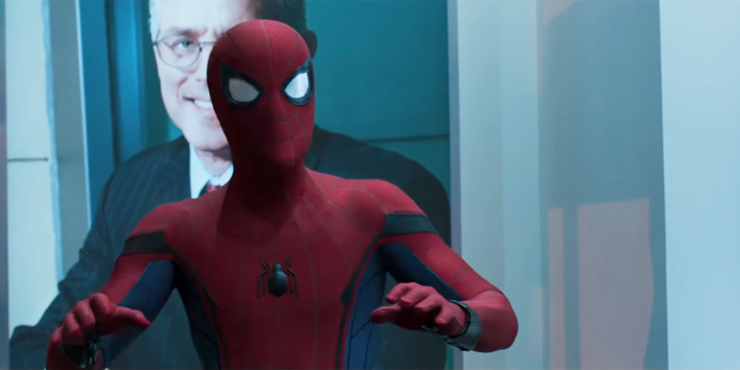
For Spidey’s third reboot in a decade-and-a-half, I’m really grateful that Kevin Feige, Jon Watts, and their army of screenwriters decided to eschew a full retelling of the origin. Feige himself said in an interview that, after two origin stories in 2002 and 2012, “we are going to take it for granted that people know that [origin], and the specifics.” And thank goodness for that.
Having said that, the spectre of Uncle Ben hangs over parts of this movie, in three moments in particular: in Tom Holland’s voice when Parker begs Ned not to let May know he’s Spider-Man because she’s already been through so much, in Holland’s face when Stark takes the suit back after the ferry incident, but most especially in Marisa Tomei’s entire performance when Parker comes home after Stark took the suit. That scene in particular is a tour de force from Tomei who has, frankly, been underutilized, though what we have gotten has been excellent. When she enumerates all the things Parker has done that he thought he was keeping from her, like sneaking out to go on patrol, the PTSD from losing her husband is etched on Tomei’s every pore. It’s obvious that she keeps it under control for the most part—and indeed, she does so again when Parker reveals that he lost the “internship”—but in that moment, she’s in several kinds of pain because she’s afraid of losing the one person she has left.
This movie also feels so very much like a New York story. I previously wrote on this site that the makeup of the Midtown School of Science and Technology was much more representative of the demographics of New York than Midtown High was in the comics by Stan Lee and Steve Ditko in the early 1960s, but it goes deeper than that. So many great New York moments here, from the neighbors all kibitzing over Spider-Man’s botched attempt to stop a car thief, which quickly devolves into a friendly conversation among neighbors; to the bodega, complete with overfed deli cat, where Parker regularly gets food (and the later bonding over it with Douglas is classic); to the tired cynicism of the teachers (the gym teacher’s response to the state-mandated Captain America PSA is a particular classic). Plus there’s all the classic high school stuff, from Parker’s crush on Liz to the awkwardness of the party to Flash’s bullying.
One thing I adore about this movie in particular, and Holland’s portrayal in general, is that he manages to be a great Peter Parker and a great Spider-Man. Tobey Maguire was a very good Parker, but his Spider-Man never felt like my favorite superhero at any point, really. Andrew Garfield had the opposite problem; he definitely was Spider-Man, but his Parker was just a typical skateboarding doofus teenager, with no hint of the brilliant kid he was supposed to be.
Holland, though, gives us both. His Spider-Man is constantly babbling and quipping while fighting (which is what Spidey is supposed to be doing), and his Parker is a brilliant young man. In fact, he’s so brilliant he sometimes doesn’t even realize it, as he gets so caught up in the superhero lifestyle that he forgets the importance of staying in school. Yet when we see him in an academic setting, it’s obvious that his brilliance is effortless. I particularly like that he came up with the formula for the webbing on his own, and uses Midtown’s science labs to synthesize it, before being given webbing by Stark in his shiny new suit.
One thing that helps with this is that the movie regularly gives Parker someone to talk to while he’s Spider-Man, whether it’s Stark or Ned or Karen. (I particularly like that the A.I. actually encourages him to kiss Liz after rescuing her while hanging upside down, a hilarious call back to the 2002 movie, made even more entertaining by his then falling down the elevator shaft before he can.) This enables the babbling, at which Holland excels, and which is one of Spidey’s most entertaining features, one that was muted in both his previous movie series. Plus Holland works beautifully with all three. Jacob Batalon is geeky perfection as Ned, and I especially love that he eventually gets to be “the guy in the chair”; Robert Downey Jr. gives us a Stark who continues to be the worst mentor ever, but at least does so entertainingly; and Jennifer Connolly’s chirpily helpful Karen is wonderful.
What’s best about this movie, though, is the same thing that made the Netflix series as appealing as they were. Most of the MCU movies are about big events and major occurrences, and rarely are the ground-level consequences even dealt with. By going small-picture, as it were, we get to see how this world of superheroes affects ordinary folks, from little things like Cap’s PSAs to big things like alien tech destroying a beloved neighborhood bodega.
Nowhere is this seen better than in Adrian Toomes, which is a magnificent performance by Michael Keaton. We first see Toomes as a workaday contractor who got a big score in getting to spearhead the cleanup of Stark Tower in 2012 only to have it yanked away from him by an uncaring federal government. (Kudos to Tyne Daly, who nails the role of the uncaring bureaucrat in her small role.) Toomes is the working-class hero twisted, as he wants to support his family, but he takes it to its nastiest extreme, killing Brice (while that wasn’t his intention, he doesn’t seem in the least bit broken up about the murder; Brice is also, it must be said, a classic fuckup, played to yeah-whatever perfection by Logan Marshall-Green) and threatening, not just Parker, but also his nearest and dearest. You understand where his villainy comes from, but it’s still villainy and he’s still scary.
This movie is a delight, a strong coming-of-age story, a strong Spider-Man movie, a good look at an aspect of the MCU rarely seen on cinema screens, and just a fun time overall. Each previous live-action version of Spidey was flawed in some way, going back to the 1977 Nicholas Hammond TV movie and followup series. Holland’s portrayal feels completely right in a way that Hammond, Maguire, and Garfield weren’t able to manage. And on top of that, it has a call-back to one of Spidey’s greatest moments, when he throws twelve tons of machinery off his back during the “Master Planner” storyline in Amazing Spider-Man #33.
Next week, more Civil War fallout, as we see the aftermath of King T’Chaka’s death and get a much better look at Wakanda in Black Panther.
Keith R.A. DeCandido has always loved Spider-Man since first seeing him on The Electric Company as a kid in the 1970s. His first comic book subscription was to Spidey Super Stories, the Electric Company tie-in comic, and when he became a professional fiction writer, his first short story (“An Evening in the Bronx with Venom” in 1994’s The Ultimate Spider-Man) and his first novel (Venom’s Wrath in 1998) starred the web-head, something he’s always taken geeky pleasure in.










